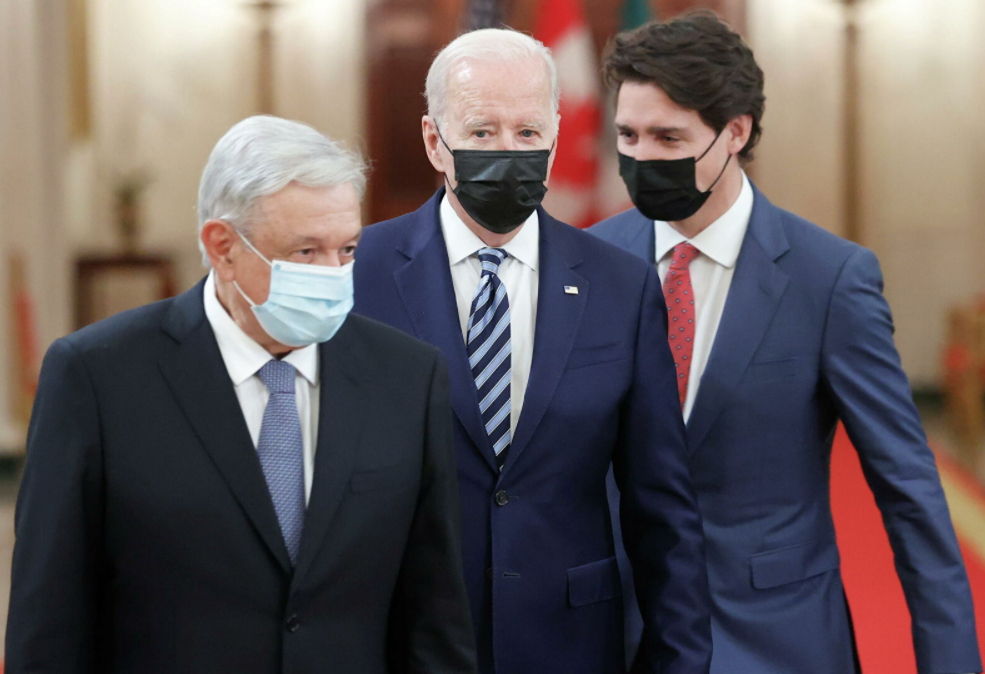The meeting between U.S. President Joseph Biden, Canadian Prime Minister Justin Trudeau, and Mexican President Andrés Manuel López Obrador at the North American Leaders’ Summit on November 18 was the framework for strengthening integration and charting a new path in line with global challenges.
First, while the crossing of Mexicans with U.S. visas into the U.S. has resumed after nearly 20 months of border closure, it is important to move forward with greater support from the U.S. government in order to increase vaccination coverage in border communities on both sides and, in turn, to move toward a secure border. In the United States, the fully vaccinated population is 59%, while in Mexico it is almost 50%, according to Our World in Data of November 18.
In this regard, a relevant agreement from the Summit was on joint preparation to face upcoming pandemics and health threats. To this end, the North American Animal and Pandemic Influenza Plan (NAPAPI), which was an effective model of binational cross-border governance to control the H1N1 pandemic and for national security reasons was sidelined by then President Trump, will be implemented.
Another relevant proposal from the Summit was to rebuild competitiveness and boost growth. To this end, it was agreed to strengthen and coordinate the supply chains of both countries and define each other’s essential industries to minimize future disruptions. It was also recognized that the region needs resilient, sustainable, diverse, and secure supply chains to ensure economic growth.
In the same vein, the aim is to strengthen the links between small and medium-sized enterprises (SMEs) in both countries, promote women’s entrepreneurship, and boost innovation. In this regard, creative, cultural, and social solidarity economic policies are central strategies for generating jobs for vulnerable groups.
Measures to combat the climate crisis
The leaders of the three countries pledged to adopt concrete measures to combat the climate crisis. On the one hand, they will seek to create a North American methane and black carbon strategy to reduce methane emissions from all sectors, especially oil and gas. They also agreed to reduce emissions from vehicles and diesel engines.
On the other hand, the governments agreed to accelerate the deployment of renewable energy, including technical assistance and the sharing of best practices and initiatives aimed at catalyzing finances and technology. A priority strategy for the U.S. government is to accelerate the transition to sustainable transportation, including the manufacture of electric vehicles.
At the U.S.-Mexico border level, it was agreed to develop plans to convene major North American states and cities as contributors to various proposed strategies aimed at accelerating climate action. Within this framework, the North American Development Bank is one of the key instruments for incentivizing environmental resilience projects.
The Mexican government reiterated the importance of migratory flows and mobility to the United States, especially in the context of the need for labor. They stressed its importance further in the framework of labor integration and the expected growth of the U.S. economy, following the bipartisan agreement on the infrastructure project. In that framework, the presidents acknowledged the complexity of the increase in irregular migration – 1.5 million irregular migrants were detained by the United States in the fiscal year 2020-2021 – and also recognized the need for effective multilevel governance prioritizing orderly, safe, and regular migration.
In that context, they agreed to establish a regional pact on migration and protection for the Americas, to promote labor mobility pathways through the promotion of temporary worker visas, and expand centralized migration resource centers in Central America, among other things. They also pledged to announce additional programs and funding to create jobs in Latin America and the Caribbean.
The viability of a development policy and effective migration control in the countries of the Northern Triangle implies reconciling processes of governability, governance and policies for greater control of institutional corruption, which will, in turn, allow financial resources to generate the expected social impact.
The meeting also agreed to combat transnational crime and terrorism and to strengthen defense collaboration by adopting a consistent approach to collect, store, use, retain, and share passenger name records in accordance with the standards and recommended practices of the International Civil Aviation Organization. The Trilateral Working Group on Human Trafficking will also be reinitiated to combat labor and sex trafficking in the region and to undertake commitments in the North American Defense Ministerial (NADM), such as regional defense and security cooperation.
Finally, President López Obrador raised the importance of strengthening the national interest in energy and electricity policies, considering the importance of reconciling policies such as controlling corruption in the allocation of contracts while encouraging competitiveness and sustainability.
In conclusion, the main agreements signed at the Summit address issues as diverse as the management of the pandemic, the reactivation of supply chains, employment, climate change, and irregular migration. The question we must ask ourselves is, which of these aspects can actually be implemented?
Translated from Spanish by Alek Langford













